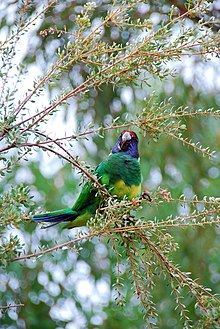Ring parakeet
| Ring parakeet | ||||||||||||
|---|---|---|---|---|---|---|---|---|---|---|---|---|

Ring parakeet |
||||||||||||
| Systematics | ||||||||||||
|
||||||||||||
| Scientific name | ||||||||||||
| Barnardius Zonarius | ||||||||||||
| ( Shaw , 1805) |

The Ring Parakeet ( Barnardius zonarius ), also known as the Ring Parakeet or Bauer's Ring Parakeet, is a species of Australian parrot. A total of three subspecies are distinguished. Together with the Barnard Parakeet , it is usually placed in the genus of the ring parakeet . However, some taxonomists see the Barnard Parakeet as a subspecies of the Ring Parakeet and include the Ring Parakeet in the genus of the Flat-tailed Parakeet .
Appearance
The ring parakeet reaches a body length of 37 centimeters. The nominate form weighs between 121 and 126 grams. The subspecies found in the extreme southwest of Australia , e.g. semitorquatus becomes significantly heavier and can weigh up to 206 grams.
The ring parakeet has a black head and neck and an upper cheek region that is black. The lower cheek region plays into the blue-violet. The throat and chest are dark green. In some individuals, this plumage is slightly bluish. The narrow yellow band that runs in the back of the back is striking. The upper side of the body is dark green and has a bluish tinge on the rump, the upper tail-coverts and the small wing coverts.
The outer middle wing covers and the outer arm covers are yellowish green and turn greenish blue towards the tips. The inner wing covers and the inner arm covers are dark green. The hand covers as well as the hand wings and the outer arm wings are black-brown. The outside flags and the tips of the flags are lined with blue-violet. The belly is yellow and turns yellowish green towards the anus and the under tail coverts.
The females are similar to the males and are colored similarly to them, but have a more dull plumage with more black-brown plumage parts. Fledglings are similar to females, but have a significantly more brownish head. All young birds not yet sexually mature have in common that they have a blue under wing stripe.
The subspecies e.g. occidentalis , which occurs south and west of the Great Sand Desert , has an overall lighter plumage. Her lower cheek region is light blue and the belly lemon yellow. The subspecies e.g. semitorquatus has a striking red headband.
Distribution area and habitat
The range of the ringed parakeet is southern, central and western Australia. They are common and widespread birds there. There are also feral populations around Sydney , Canberra and Melbourne - three cities that are outside the natural range - which are very likely to have descended from captive refugees. For Canberra and Melbourne, there is evidence that these feral populations also reproduce.
Ring parakeets are a very adaptable species that populate a wide variety of habitats. They occur in the dense coastal forests in the extreme southwest as well as in the agricultural Wheatbelt , in mallee areas , in semi-arid eucalyptus savannas, in arid acacia-casuarina bushland and in very sparsely overgrown desert regions. In arid regions, however, ring parakeets are dependent on the fact that trees along watercourses can serve as breeding trees for them. Due to their adaptability, they are the most common species of the flat-tailed parakeet subfamily in large parts of Western Australia.
behavior
Ring parakeets are very showy birds in their range because of their lively behavior. Unlike the Barnard Parakeets , they are very noisy birds. They occur predominantly in pairs and in small schools. They peak in activity in the early morning and in the late afternoon. During the hot lunchtime, they are mostly in dense tree tops or in dense bushes.
Ring parakeets mainly live on seeds, fruits, nuts, berries, nectar, flowers, buds as well as leaf saplings and insects and their larvae. In the southwest of their range, ring parakeets look for food on trees rather than on the ground. They prefer a few types of eucalyptus and with their long beaks are able to tear open and split the cup-shaped seed pods. Ring parakeets can cause considerable damage on orchards. Similar to Cape Parakeets and Stanley's Parakeets, they especially like to eat apples and pears.
The breeding season depends on the distribution area. The southern populations usually breed from August to December. In the interior of Australia, the amount of precipitation determines the start of reproduction. Ring parakeets are cave-breeders who prefer to use eucalyptus trees as a breeding tree, which are located near water points or courses. The clutch consists of four to seven eggs, which are placed on a layer of rotting wooden mulms at the bottom of the nest cavity. It only breeds the female. The incubation period is 20 to 22 days. Studies have shown a very high reproduction rate for ring parakeets: 30 clutches were examined over an observation period of four years. 117 young birds hatched from the 144 eggs found, 108 of which fledged.
supporting documents
Individual evidence
- ^ Forshaw, p. 419 and p. 421
- ^ Forshaw, pp. 419 and 420
- ^ Forshaw, p. 420
- ^ Forshaw, p. 421
- ^ Forshaw, p. 420
- ^ Forshaw, p. 421
- ^ Forshaw, p. 427
- ^ Forshaw, p. 427
literature
- Joseph M. Forshaw : Australian Parrots. 1st German-language edition. Volume 2, Arndt-Verlag, Bretten 2003, ISBN 3-9808245-2-7 .
Web links
- Videos, photos and sound recordings of Barnardius zonarius in the Internet Bird Collection
- Barnardius zonarius onthe IUCN Red List of Threatened Species .
